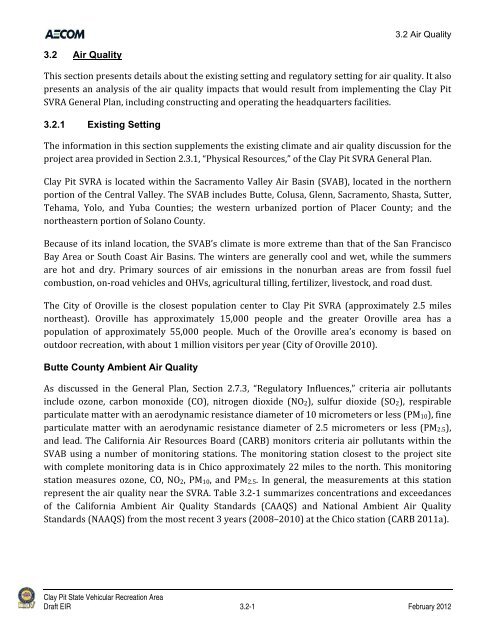Draft Environmental Impact Report - California Off Highway Vehicle ...
Draft Environmental Impact Report - California Off Highway Vehicle ...
Draft Environmental Impact Report - California Off Highway Vehicle ...
Create successful ePaper yourself
Turn your PDF publications into a flip-book with our unique Google optimized e-Paper software.
3.2 Air Quality<br />
3.2 Air Quality<br />
This section presents details about the existing setting and regulatory setting for air quality. It also<br />
presents an analysis of the air quality impacts that would result from implementing the Clay Pit<br />
SVRA General Plan, including constructing and operating the headquarters facilities.<br />
3.2.1 Existing Setting<br />
The information in this section supplements the existing climate and air quality discussion for the<br />
project area provided in Section 2.3.1, “Physical Resources,” of the Clay Pit SVRA General Plan.<br />
Clay Pit SVRA is located within the Sacramento Valley Air Basin (SVAB), located in the northern<br />
portion of the Central Valley. The SVAB includes Butte, Colusa, Glenn, Sacramento, Shasta, Sutter,<br />
Tehama, Yolo, and Yuba Counties; the western urbanized portion of Placer County; and the<br />
northeastern portion of Solano County.<br />
Because of its inland location, the SVAB’s climate is more extreme than that of the San Francisco<br />
Bay Area or South Coast Air Basins. The winters are generally cool and wet, while the summers<br />
are hot and dry. Primary sources of air emissions in the nonurban areas are from fossil fuel<br />
combustion, on‐road vehicles and OHVs, agricultural tilling, fertilizer, livestock, and road dust.<br />
The City of Oroville is the closest population center to Clay Pit SVRA (approximately 2.5 miles<br />
northeast). Oroville has approximately 15,000 people and the greater Oroville area has a<br />
population of approximately 55,000 people. Much of the Oroville area’s economy is based on<br />
outdoor recreation, with about 1 million visitors per year (City of Oroville 2010).<br />
Butte County Ambient Air Quality<br />
As discussed in the General Plan, Section 2.7.3, “Regulatory Influences,” criteria air pollutants<br />
include ozone, carbon monoxide (CO), nitrogen dioxide (NO2), sulfur dioxide (SO2), respirable<br />
particulate matter with an aerodynamic resistance diameter of 10 micrometers or less (PM10), fine<br />
particulate matter with an aerodynamic resistance diameter of 2.5 micrometers or less (PM2.5),<br />
and lead. The <strong>California</strong> Air Resources Board (CARB) monitors criteria air pollutants within the<br />
SVAB using a number of monitoring stations. The monitoring station closest to the project site<br />
with complete monitoring data is in Chico approximately 22 miles to the north. This monitoring<br />
station measures ozone, CO, NO2, PM10, and PM2.5. In general, the measurements at this station<br />
represent the air quality near the SVRA. Table 3.2‐1 summarizes concentrations and exceedances<br />
of the <strong>California</strong> Ambient Air Quality Standards (CAAQS) and National Ambient Air Quality<br />
Standards (NAAQS) from the most recent 3 years (2008–2010) at the Chico station (CARB 2011a).<br />
Clay Pit State Vehicular Recreation Area<br />
<strong>Draft</strong> EIR 3.2-1 February 2012








